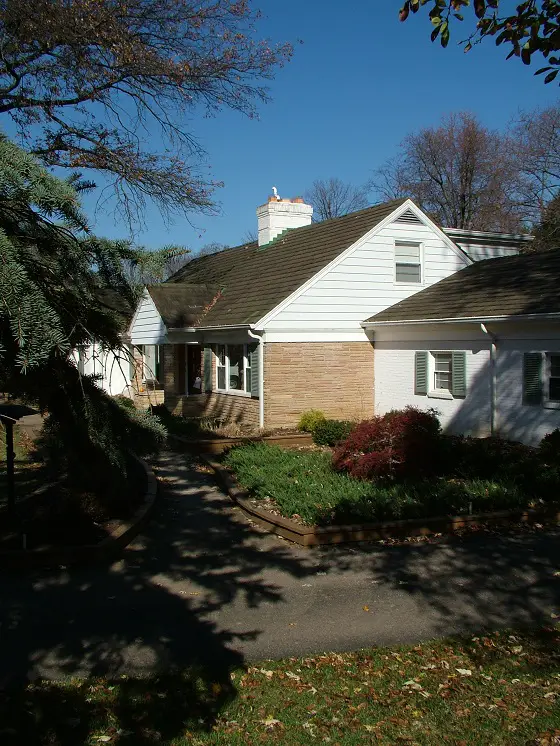Replace Vinyl Siding With Brick

You can install a veneer of brick, stone or other masonry on a house like this, but it's very labor intensive. Buy lottery tickets, lots of them. © 2017 Tim Carter
Replace Vinyl Siding With Brick TIPS
- Big angle irons required
- Brick veneer leaks water
- Water membrane on sheathing
- Flashings at all horizontal breaks
- CLICK HERE to Get Tim's FREE & FUNNY Newsletter!
DEAR TIM: My husband and I purchased a house with a crawlspace in the country on 20 acres. I do not like the vinyl siding on the home and would love to replace it with brick. Is it possible to do this? Can I get a solid brick home instead of brick veneer? What is the difference between the two? Debbie F., Swansea, SC
DEAR DEBBIE: You and a boatload of other people may not believe this, but it may be very possible to strip off the vinyl siding and install brick on this house. In fact, I can't think of one obstacle in accomplishing what you want to do other than money.
Depending upon how this home was built, it may be easy or somewhat difficult to modify the foundation so the brick can be installed.
CLICK HERE to get FREE & FAST BIDS from local bricklayers who can install brick veneer.
Solid vs Veneer
Let's first discuss the difference between solid brick and brick veneer. Solid brick or masonry structures use the brick or masonry to support the loads within the walls and any roof loads that bear down on the brick walls. A solid brick or masonry wall in a residential house is often eight-inches thick and sometimes 12-inches thick. The inner layers of the masonry may be brick or they can be concrete masonry units typically called block.
Veneer Non-Structural
A brick veneer home uses one layer of brick that is non-structural. The brick are the first barrier to stop weather from getting inside the home. The roof load doesn't bear down on the brick nor does any weight of the walls just behind the brick transfer itself to the brick. The veneer is almost always just one brick thick.
Tons Of Weight
But just because the brick is only a thin skin, this doesn't mean it is not heavy. What's more, to keep the brick and mortar crack-free for many years, it needs to have a superb foundation underneath it.
Create New Foundation
If this home was built with a typical spread concrete footing that is 16 to 24-inches wide and has a concrete block or poured concrete foundation, the job will be relatively easy. To lay the brick, a four-inch wide concrete block wall needs to be laid next to the existing foundation.
This new foundation will transfer the load of the brick down to the footer.
Angle Iron Solution
It may be possible to thru-bolt a heavy-duty angle iron to the existing foundation to support the brick. This decision can only be made after a residential structural engineer visits your home.
CLICK HERE to get FREE & FAST BIDS from local bricklayers who can install brick veneer.
Slab Homes - UGH!
The job is a little more difficult if your home is built upon a concrete slab. If this is the case, a new spread footing will have to be poured below the frost level in your area and then a foundation wall that supports the brick must be built upon this new footer.
You may have a unique turn-down slab that will allow you to bolt an angle iron onto the vertical side of the slab, but once again, this should only be done under the direction of a structural engineer.
Brick LEAKS!
Be aware that the new brick veneer wall will leak all sorts of water when a driving rain beats against it. For this reason, the builder and mason must install a water barrier on the side wall of the house after you strip the vinyl siding away. This membrane must be installed so that no water can get behind any windows or doors.
Be sure to consult with your local building department before you start any work. There are many building code provisions with respect to installing brick veneer. In addition, there are extra steps a masonry craftsman will take to ensure your home stays bone dry.
Mold Issues
Tens of thousands of homes built with brick veneer have become victims of both mold and wood rot due to improperly installed brickwork. The industry has known for years that brick walls leak water and that water must be collected and re-channeled to the exterior of the house.
Flashings Mission Critical
The way this is accomplished is simple, but requires attention to detail by both the builder and the bricklayers. Special base flashings need to be installed on top of the foundation that lap up behind the water membrane on the walls. This base flashing must be sealed at all overlap joints, inside and outside corners. Weep holes or slots in between the brick on the first row of brick that rest upon the foundation allow water that streams down the back of the wall to escape to the outdoors. This same weep hole detail must be used above all doors and windows.
Flashings must also be placed under brick sills that are found under windows and doors. The vertical joints between these brick often allow vast amounts of water into the brickwork. The flashings collect the water and redirect it immediately to the exterior of the wall just under the sill brick.
CLICK HERE to get FREE & FAST BIDS from local bricklayers who can install brick veneer.
Editor's Note: CLICK HERE to read about Ralph's story on covering his house with brick veneer.
Column 595
11 Responses to Replace Vinyl Siding With Brick